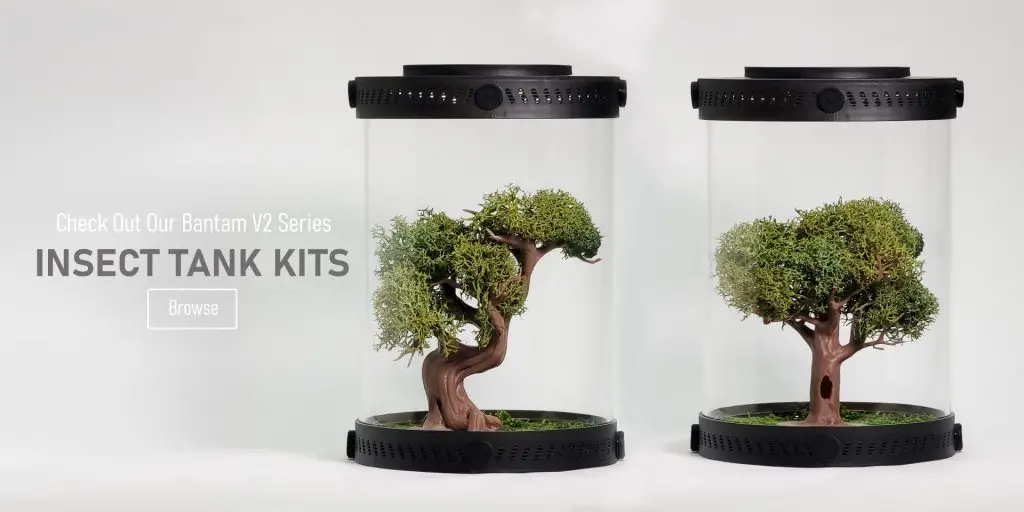Are you wondering what the best Praying Mantis foods are?
It’s important to provide the right type of food so that they stay healthy and strong.
Without the right eating habits, they won’t be able to reach adulthood.
In this article, you’ll learn what praying mantis eat and how to feed them correctly with a quick step-by-step feeding guide.
So, let’s find out how to keep your Praying Mantis happy and healthy with the right type of food.
Table Of Contents:
ToggleWhat Does Praying Mantis Eat?
In the wild, the praying mantis diet varies depending on the species and the type of prey that is accessible.
Generally speaking, smaller prayer mantis feed on small insects such as springtails, isopods, and aphids, while the larger species prey on even bigger insects such as grasshoppers or crickets.
They usually hunt during the night, using their powerful legs and long antennae to search for prey.
They’ll also eat during the day if an easy opportunity presents itself.
In addition to hunting and eating insects, larger praying mantes also enjoy eating small animals such as rodents, lizards, and even birds.
It’s important to note, however, that these larger prey are usually only found in their natural environment and not in captive situations.
Praying mantis also have a love for plant matter, such as juicy fruits and vegetation.
This helps keep them hydrated and ensures that they have the energy to hunt during the night.
Foliage is also great for providing them with the necessary minerals and vitamins that they need to stay healthy.
Create the perfect home for your mantis with our Customizable Mantis Enclosure Kits, designed to meet all their habitat needs.
Buy Praying Mantis Food
When it comes to buying food for your Praying Mantis, there are a few different options, so it is important to consider which one is best for your pet.
There are many specialists in Praying Mantis food packages available in stores or online.
They usually contain a variety of live food items such as crickets, worms, and flies.
You can also purchase dried food such as pellets specially designed for Praying Mantis which are easy to store and last a long time.
Lastly, you can catch your food, though I wouldn’t recommend this often due to the risk of potential parasites.
When To Feed A Praying Mantis
Feeding your Praying Mantis should be done at least once a day, especially if it is a baby or juvenile.
Adult mantises can go longer without eating, but it is still important to offer food at least every two to three days.
During the winter, you can reduce the amount of food you offer to your mantis.
In cold temperatures, their metabolism lowers and they don’t need as much energy to function properly.
If the temperature is too cold and the food isn’t being eaten, it’s best to stop feeding until the weather warms up.
Common Mistakes
One of the most common mistakes in providing food for a praying mantis is overfeeding.
Too much food could cause indigestion and potentially kill the mantis.
If you notice that your mantis is not eating all of the food provided, then reduce the portion size.
Another mistake is not providing the right type of food. Praying mantis will usually target and hunt down their prey in their enclosure.
Gut-loaded insects such as cockroaches, crickets, grasshoppers, and millipedes are considered to be the best food sources.
Providing these insects provides variety and more nutrition for your mantis.
Feeding a mantis the wrong type of food, such as pellets, is also a mistake.
Even though pellets are formulated for insect eaters, they lack essential nutrients. A diet of only pellets is not suitable for a praying mantis.
Instead, a variety of live food should be given to maintain the health of the mantis.
Conclusion
In conclusion, providing the right food for your Praying Mantis is essential for its health and well-being.
With this DIY Praying Mantis food guide, you now know what to feed your praying pet, how to feed it, and when to feed it.
Just be sure to avoid any common mistakes to help keep your Praying Mantis happy and healthy.
Create the ideal habitat for your praying mantis with our species-specific soil mixes and Insect Enclosure Kits. These products provide everything you need for a thriving Mantid habitat.
Frequently Asked Questions
The best food for praying mantises are live insects such as crickets, flies, moths, and grasshoppers.
They can also eat other small invertebrates such as spiders and roaches.
No, praying mantises are carnivorous and do not eat fruit. They require a diet of live insects or other small invertebrates to survive.
If you have a pet praying mantis, you should provide it with a regular supply of live insects to eat. If you have encountered a wild praying mantis, it is best to leave it alone and not attempt to feed it.
No, praying mantises cannot eat a banana or any other type of fruit.
They are strictly carnivorous and require a diet of live insects or other small invertebrates to survive.
It can be difficult to tell if a praying mantis is hungry, but they will typically display more active and alert behavior when they are hungry.
They may also become more aggressive and attempt to catch any insects or prey that enter their enclosure.
No, praying mantises are strictly carnivorous and do not consume fruit or plant matter. They require a diet of live insects or other small invertebrates to survive.
Praying mantises do not have a favorite food as such, but they will typically eat any live insect that they can catch and subdue.
Common prey items for mantises include crickets, flies, moths, grasshoppers, and other small invertebrates.



